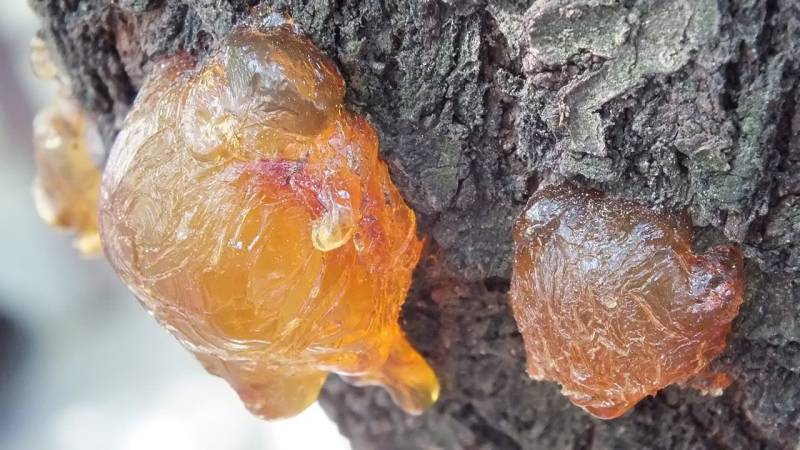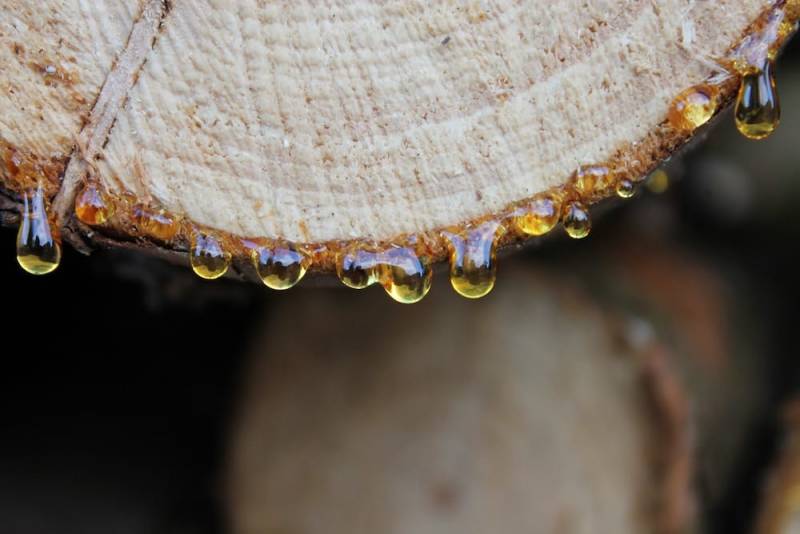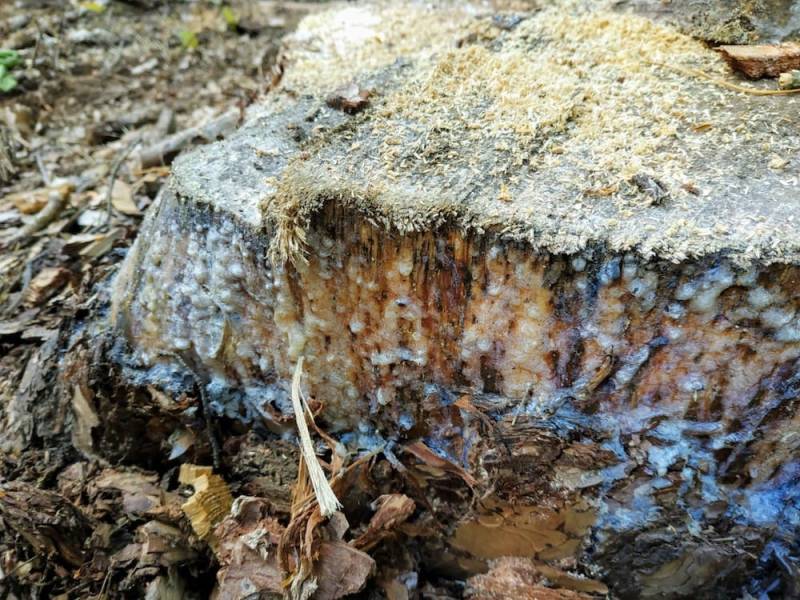
16 ways resin helps you in the wilderness – Find out the most important ones here
👉 The key facts from this guide
- Resin is a natural product that is mainly secreted by trees. It is a particularly viscous liquid that is not water-soluble and hardens over time.
- Resin has many applications in the wilderness. It can be used as an antiseptic agent to treat wounds and alleviate skin rashes.
- Resin can also be used as a natural adhesive to make primitive weapons and tools, to plug holes and seal containers.
- Resin is an excellent fuel and can be used to make torches and candles as well as a tinder to start fires.
- Resin can be obtained in various ways, such as by tapping the tree or collecting already leaked resin. It is important not to harm the tree in the process.
- When storing and preserving resin, it should be kept in sealable containers and stored in a cool and dry place. Safety precautions should be taken when handling resin to avoid injuries and allergic reactions.
There are countless different ways in which you can use and apply resin in nature.
You will learn what resin is and in this article, I will explain 16 application examples to you in more detail.
What is resin anyway?
Resin is a natural product that is secreted by animals and plants, primarily by trees.
Today, I will only focus on the latter.
Natural resin is a particularly tough liquid that is not water-soluble. The older the resin, the harder it becomes.

Trees produce resin mainly when they are injured.
This way, they naturally seal wounds. However, resin also has a repairing effect on minor cracks or fungal infections.
Where can I find resin? How can I extract it?
Coniferous trees are the suppliers that can provide you with the largest supply of resin. Particularly suitable for this purpose are spruces and pines.
Definitely try your luck at tree stumps that have been recently felled. There, a larger amount of resin often occurs.

When collecting resin, be prepared to have very sticky hands. However, you can clean them very well with oil, among other things.
It is important that you never intentionally injure a tree just to obtain resin.
Look around, keep your eyes open. You will find enough
- Resin is a natural product that is mainly secreted by trees. It is a particularly viscous liquid that is not water-soluble and becomes harder over time.
- Resin has many applications in the wilderness. It can be used as an antiseptic for treating wounds and relieving skin rashes.
- Resin can also be used as a natural adhesive for making primitive weapons and tools, patching holes, and sealing containers.
- Resin is an excellent fuel and can be used to make torches and candles, as well as to ignite fires as tinder.
- Resin can be obtained in various ways, for example, by tapping the tree or collecting already exuded resin. It is important not to damage the tree while doing so.
- In storing and preserving resin, it should be kept in sealable containers and stored in a cool and dry place. When handling resin, safety precautions should be observed to prevent injury and allergic reactions.
resin that is already present. So, never damage a tree.
The 16 ways in which resin helps you in the wilderness
To make it easier to understand, I have divided the different ideas I want to present to you today into three categories: self-help, adhesive, and light & warmth.
Resin for self-help
- 1. Antiseptic effect
- Especially pine resin has an antiseptic, astringent, anti-inflammatory, and antibacterial effect. Thus, resin is an excellent choice for different types of injuries in self- and comradeship, as well as in first aid.
- 2. Stop bleeding
- Warm up the resin a bit to make it more liquid and thus easier to shape. Then apply it to the bleeding wound. This way, you can quickly and effectively stop minor, more local bleeding. In addition, you actively counteract inflammation, among other things.
- 3. Treat wounds
- After disinfecting and cleaning a wound, apply resin. Proceed as if you were applying superglues. This seals the wound, inhibits inflammation, has antibacterial properties, and provides quick help when you don't have adhesive tape at hand.
- 4. Alleviate rashes
- Treat rashes with ointments, tinctures, and wound balm made from resin. With the many positive properties of resin, you will be able to alleviate the rash. Please don't hesitate to leave a comment if you would like a separate article on how to make these products.
- 5. The resin-gum
- Use resin-gum from a fir or spruce tree as chewing gum. Look for resin-gum that is already somewhat hard. Fresh, soft resin-gum will only stick to your teeth. It kills germs, provides a particularly fresh breath, and strengthens the immune system. The young, soft resin-gum is somewhat bitter; you should only suck on it. It is best to stick it under your palate to do so. Before you can bite into the resin-gum, let it soften for a few minutes; otherwise, it will only break, and you will have a crumbly mass in your mouth.
Resin-gum as adhesive
- 6. Production of primitive weapons and tools
- As with earlier peoples, long before us, there is the possibility of using resin-gum to glue primitive weapons and tools. Connect, for example, a feather with a self-made arrow.
- 7. Patching holes
- Due to its sticky consistency, resin-gum is also ideal to patch small holes. For example, in your tent or in your tarp (You can find everything about a tarp in the article "What is a Tarp? [Sizes, Costs, Assembly Variants]").
- 8. Waterproof seal
- Use resin-gum to make your boat, canoe, raft, or primitive containers waterproof. This way, you won't sink on your journey across the river and won't lose any water during transportation.
- 9. General Gluing
- Use resin for all other gluing work you want to do in nature. Resin is a multifunctional adhesive for natural products. In my online program "Wildimpuls" I show you in a video how to make Stone Age glue.
Resin for Light & Warmth
- 10. Torch
- Heat the resin until it is very liquid. Dip a piece of fabric into the liquid resin and wrap it around a piece of wood. You have now created a torch that will burn for a very long time.
- 11. Extend the Burning Time of a Torch
- If you already have another torch, place small pieces of resin in your torch. This will significantly increase its burning time and allow you to make it through the dark night.
- 12. Provisional Candle
- Wrap a small, handy and elongated piece of wood with soft resin. If you now light this, you have a provisional and primitive candle. This candle is a mini-torch.
- 13. Natural Candle
- Dry a mullein plant (also known as woolly mullein) and dip it in melted liquid resin. After it has dried, use this plant as a candle. Light up your tarp at night.
- 14. Tinder
- Resin is highly flammable, it burns excellently and for a particularly long time. Therefore, resin is ideal as a tinder. Pine wood also works very well for this purpose.
- (Recommended reading: Meaning, origin and application of pine wood in my article "What is Pine Wood?").
- 15. Keep the fire burning
- Use resin to keep your fire burning longer. Resin burns especially long, making it ideal for this purpose. (In my article "How to start a fire? [in 10 steps to success]" you'll find all the information you need for a perfect fire)
- 16. Fire starter under all conditions
- Resin is particularly easily flammable under all conditions. So, it will be much easier for you to ignite a fire in the rain if you have resin available. If you are keen to learn more about tinder and fire-making, take a look at my book "The Fire Primer".
Different types of resin and their specific properties
Pine resin and spruce resin are two of the most common types of resin found in our local forests.
Pine resin is characterized by its yellowish-brown color and strong scent, while spruce resin is more whitish to transparent and has a milder smell.
Both types of resin have antiseptic properties and can be used as a natural adhesive or for making fire.
But be careful: Not every tree produces resin! Make sure you only collect resin from coniferous trees, as deciduous trees generally do not produce usable resin.
Techniques for harvesting resin
Resin can be harvested in various ways.
- One option is tapping the tree: Carefully cut into the bark of the tree, not too deep, so that the resin can flow out of the cut. It's important not to harm the tree - after all, it's your friend and partner in the wilderness!
- Another method is collecting already excreted resin: Look for spots where the tree naturally secretes resin and collect it from there.
- Finally, you can also obtain resin through distillation by heating resinous branches and needles and collecting the liquid resin. However, this method is more suitable for advanced bushcrafters and requires some experience and equipment.
Tips for storing and preserving resin
To be able to use your collected resin for a long time, proper storage and preservation is important.
Remove impurities such as bark pieces or needles before filling the resin into sealable containers.
Glass or metal containers are best for this purpose. Make sure the container is tightly closed to prevent the resin from drying out and sticking together.
Store the resin cool and dry to maintain its quality and durability.
Safety precautions when handling resin
Even though resin is a wonderful natural product, there are some safety precautions to consider when handling it.
Sharp tools such as knives or saws may be used when tapping the tree or collecting resin. Be sure to always work carefully and cautiously to avoid injury. Wear gloves if necessary to protect yourself from cuts.
Another important aspect is protection against allergic reactions. Some people are sensitive to resin, especially its essential oils.
If you know you are sensitive to resin or have no experience with it yet, test a small amount on an inconspicuous area of skin first to rule out possible allergic reactions. When in doubt, it is always better to be safe than sorry.
What do you use resin for?
Did you learn something new from this article, or were these 16 possibilities already known to you?
You are welcome to tell us more in the comments!


Author of the guide
Martin Gebhardt
Hey, I'm Martin. On my blog, you will learn the basics and numerous details about living in the wild. I think survival, bushcraft and the good life in nature are the keys to happiness. Find me here on Instagram or on YouTube. You can find more about my mission on the About Me page.
Was this guide helpful?
112 people found this guide helpful.
4.96 out of 5 points (113 Ratings)
Comments (0)
This post may contain affiliate links. So if you click on the links and make a purchase, I will receive a small commission at no additional cost to you. Click here, to learn more about it.


